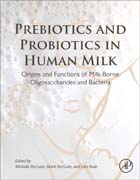
Prebiotics and Probiotics in Human Milk: Origins and Functions of Milk-Borne Oligosaccharides and Bacteria
McGuire, Michelle
McGuire, Mark A
Bode, Lars
Prebiotics and Probiotics in Human Milk: Origins and Functions of Milk-Borne Oligosaccharides and Bacteria provides a comprehensive, yet approachable, treatise on what is currently known about the origins and functions of human milk oligosaccharides (HMO), the complex sugars in milk that are not digested by the infant. The book examines how HMOs and bacteria in human milk may function independently and coordinately to influence both maternal and infant health. Human milk is the only food designed? specifically to nourish humans, indeed representing the essence of a perfect functional food.? And although researchers have been studying its composition for decades, surprisingly little is really understood about the origins and functions of its myriad components, an area that is especially true for HMOs and bacteria. This book provides a thorough review of the newest research on these inter-related milk constituents as written by a team of experts from both academia and industry who actively conduct HMO and human milk microbiome research as they endeavor to apply this new knowledge to infant nutrition. Each chapter provides objective rationale for what research is still needed in this rapidly evolving area, also discussing the challenges and opportunities faced by the industry in adding HMO and microbes to infant food products. This book is a valuable resource for nutrition researchers focused on infant nutrition, food scientists and product developers working on infant formula, and clinicians interested in broadening their understanding of the benefits of human milk for infants. Presents a reader-friendly, highly-curated text that includes a review of the literature related to origins, variability, metabolism, and functions of HMO and human milk bacteriaDiscusses the potential implications of HMO and milk microbiota to industry - for instance, utilization in the dairy industry and infant formulaConsists of learning aids, such as pull quotes, critical summary statements, and an extensive list of published literature throughout INDICE: Section A: Background, Structures, Synthesis, and Analysis 1. From Bifidus Factor to Human Milk Oligosaccharides: A Historical Perspective on Complex Sugars in Milk 2. Structures, classification and biosynthesis of human milk oligosaccharides 3. Oligosaccharides in the milk of other mammals 4. Analytical Methods to Characterize Human Milk Oligosaccharides Section B: Potential Functions and Benefits 5. Oligosaccharide metabolism in the breastfed infant 6. The Role of Human Milk Oligosaccharides in Host-Microbial Interactions 7. Potential public health impact of human milk oligosaccharides 8. Human Milk Oligosaccharides as Modulators of Intestinal and Systemic Immunity Section C: Challenges and Opportunities 9. Making Human Milk Oligosaccharides Available for Research and Application - Approaches, Challenges, and Future Opportunities 10. Complex Human Milk Sugars - Summary and Research Gaps Section D: Background, Methods, Origin, and Interpretation 11. Isn't Milk Sterile? A Historical Perspective on Milk Microbes 12. From the Human Milk Microbiota to the Human Milk Metagenome: Evolution of Methods to Study Human Milk Microbial Communities 13. Maternal Factors Related to Variability in the Human Milk Microbiome 14. Origin of Human Milk Bacteria Section E: Human Milk Microbes and Health 15. An Evolutionary, Biosocial Perspective on Variation in Human Milk Microbes and Oligosaccharides: An Example of Eco-Hemeorhesis 16. Infectious Mastitis During Lactation: A Mammary Dysbiosis Model 17. Probiotics during the perinatal period: Impact on the health of the mother and infant Section F: Challenges and Opportunities 18. Human Milk Microbes - Summary and Research Gaps
- ISBN: 978-0-12-802725-7
- Editorial: Academic Press
- Encuadernacion: Cartoné
- Páginas: 576
- Fecha Publicación: 03/10/2016
- Nº Volúmenes: 1
- Idioma: Inglés
